After a ‘train wreck’ of a start, Geology 101 helps redefine student success
Jennifer Roberts doesn’t hold back when describing her first attempt at active learning in a large lecture course.
“It was a train wreck,” said Roberts, a professor of geology who is now chair of the department. “It was bloody. Students were irate.”
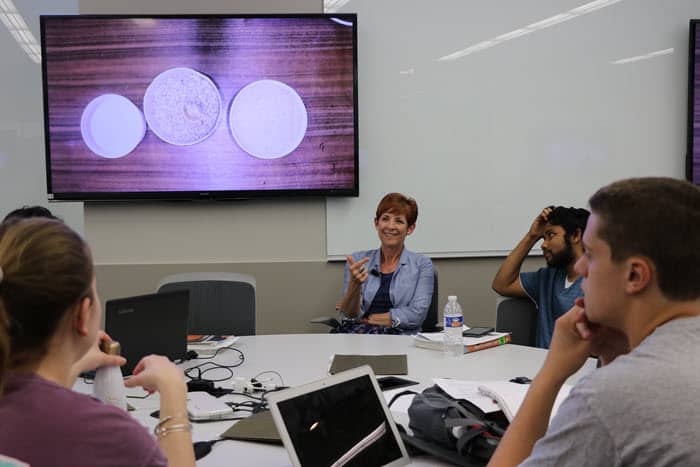
This was in Geology 101, a required course for geology majors and one that typically draws a large number of engineering students. Starting in 2013, Roberts worked with a post-doctoral teaching fellow, Kelsey Bitting, to transform the class. They cut back on lecturing and devoted more time to group discussion and guided inquiry, with worksheets and in-class problem-solving. They introduced weekly reading quizzes and in-class questions to gauge understanding. They had students do more out-of-class writing. They also adopted two-stage exams and eliminated multiple-choice questions.
Essentially, she said in an interview in 2014, they made “this a class about the work students put into it and not necessarily about who had the old test that they memorized or just who was good at taking tests.”
Geology 101 is just one of hundreds of classes that have been transformed over the past few years as the university has emphasized the importance of retaining more students and helping them graduate. It illustrates, though, the hard work that has gone into raising retention and graduation rates at KU.
This fall, 86.2% of last year’s freshman class returned, compared with a low of 77.8% in 2008. That’s a phenomenal accomplishment made possible by the work of everyone from instructors like Roberts who have adopted more effective teaching practices to advisors who have helped students make better choices to administrators who have created new support programs and allocated money and resources to address a collective problem. These changes have helped shift the culture of teaching to one that emphasizes learning for all students.
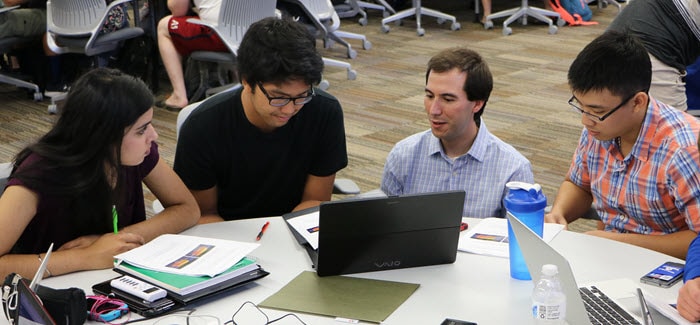
Geology 101 also illustrates the importance of shared responsibility and community building in the success of students. For instance, Roberts’ remake of the course involved a teaching fellow, a second instructor, graduate teaching assistants and several undergraduate teaching assistants. The second instructor has been crucial for maintaining continuity because that person becomes the lead instructor in the ensuing semester. Noah McLean, Andreas Möller and Craig Marshall, among others, have been instrumental in maintaining that continuity and in continuing the evolution of Geology 101.
Having multiple instructors and teaching assistants in a classroom allows for group work, makes it easier for students to ask questions and get help with challenging course material, and makes large classes much more personal. New classrooms in the Earth, Energy and Environment Center and the LEEP2 engineering building have improved the atmosphere, too. The rooms in those buildings are in high demand, largely because their layout promotes interaction and makes large classes feel smaller than those in the stadium-style seating of Budig Hall.
McLean, an assistant professor of geology, said that the traditional layout for large classrooms intimidated many students and dissuaded them from asking questions. In active-learning classrooms, “you’re only looking at eight other people, and it’s much easier to bring students in and have a class-wide discussion,” McLean said.
‘Equity between men and women’
The series of changes made in Geology 101 has worked. Despite student complaints, more started getting C’s rather than D’s. Underrepresented minority students made substantial gains, with the number receiving D’s or F’s or withdrawing falling 5.6% between 2009 and 2016 even as more underrepresented students took the class.
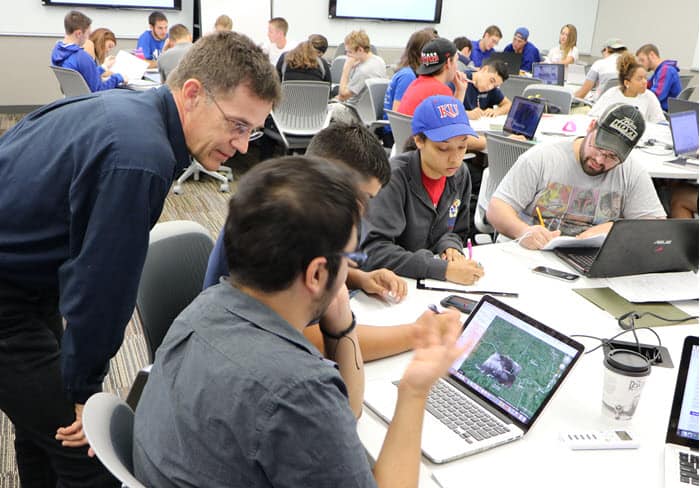
More impressively, women in the class began performing significantly better in that same metric (a decline of 9.5%). Roberts said that women often accounted for 80% of the students who withdrew from the class or received D’s or F’s. In 2017, she said: “We now have equity between men and women.”
The work isn’t done, either in Geology 101 or in other classes across the university. In many ways, it has only begun, and we have a long way to go to achieve the type of widespread equity and achievement we hope to see. We should definitely celebrate, but we still have to keep pushing.
A year after remaking Geology 101, Roberts offered this reflection:
“The advice I have been giving the people who have started, especially in designing courses from scratch with this, is to make sure that they are choosing topics that they are really excited about because this can be a grind,” Roberts said. “And if you’re not really excited about going to class and sharing that information with the students, I don’t think you’re going to do it very well.”
A Harry Potter education model for a ‘Hunger Games’ generation?
I’ve been doubtful about the emergence of a Generation Z. Strangely, Harry Potter and Katniss Everdeen, along with some reassurances from Pew Research, have me reconsidering.
Before I get to Hogwarts and District 12, though, I need to provide some background.
A few years ago, two of my students, eager to look behind the hype of marketers who claimed to see into the minds and habits of a post-millennial generation, came away frustrated. After semester-long research projects, they both asked the same questions: Who can really define a generation? And is “generation” just a convenient label that older people apply to younger people they don’t understand?
A baby boom generation made some sense because it was part of a demographic shift, the students said. Yes, today’s students are certainly different, but the “generation” labels that have been applied seem more of a put-down than an amalgamation of meaningful, or valid, characteristics.

Michael Dimock of the Pew Research Center explained some of the haziness of generational labels earlier this year when he wrote that Pew researchers were adopting the Generation Z category in their work. He wrote:
“Generational cutoff points aren’t an exact science. They should be viewed primarily as tools” for analyzing views on things like work, education, social issues and politics. Pew defines Generation Z as anyone born in 1997 or after. Others see Generation Z as starting earlier, and some place the starting point as late as 2005. By most definitions, though, traditional college-age students now consist solely of Generation Z, and the oldest in that group have already graduated.
What does that mean?
I thought about my students’ search for Generation Z as I listened to speakers at the Educause 2019 conference in Chicago recently. My students’ questions were – and still are – valid. Their search for a Generation Z may just have been a few years premature, though.
The racial and ethnic diversity of this generation — and how that diversity shapes views and expectations — has rightly received considerable attention. At Educause, though, the father and son team of David and Jonah Stillman made a case for “generational personalities,” which they said formed from experiences in adolescence. Many of those experiences are tied to significant economic and cultural events. Here are a few of the characteristics that the Stillmans said separated millennials from Generation Z.
Millennials
- Came of age during an economic boom.
- Parents, mostly baby boomers, told them they could do anything.
- Went through childhood during what the Stillmans called “the self-esteem movement,” when everyone got a trophy just for participating.
- Parents preached a message of college at any cost – apparently even to themselves – and told their children they could change the world.
- Jobs were about seeking meaning and changing the world.
- Technologically minded but with a clear separation between online and in person.
Generation Z
- Came of age during and after the 2007-2008 recession, when their parents’ net worth plummeted and they saw seemingly unsinkable companies barely able to stay afloat.
- They are realists. Their parents, mostly from Generation X, emphasized the need to compete and win. (If you doubt this, just do a search for “TikTok famous.”)
- Watched as millennials took on enormous debt to pay for college, even as many employers started to emphasize skills rather degrees.
- Jobs are about money. Full stop.
- See few boundaries between physical and digital. (Think Pokemon Go.) They even saw online companies begin to create physical stores, another case where they see “no line at all” between online and in person.
Even popular culture icons offered competing messages. Millennials read about and watched Harry Potter, a young wizard with a tight group of friends who grappled with the meaning and purpose of their magic powers. Generation Z read about and watched Katniss Everdeen, a young rebel in a dystopian nation who is chosen for a fight to the death in The Hunger Games. The message: one against the world; win or die; children are expendable.
This is all a broad-brush picture, of course, but I find that much of it rings true. After all, enrollment in business schools has soared as enrollment in the liberal arts has declined. Many students are working 20-plus hours a week to help pay their college bills. They want flexibility in their schedules and access to technology always. Most students and parents still see value in college, but they look closely at price and consider their return on investment.
So what does this mean for higher education? The Stillmans offered these observations and suggestions:
Get on their radar earlier
Many of these students are trying to make college and career decisions much earlier than previous generations did. They crave certainty and security in their careers. Universities that tap into that desire for a clear pathway have a better chance of reaching those students than those that wait. Relatedly, these students want to know what universities have to offer. They seek out winners and opportunities, and they want to see that reflected in their schools.
Group work is harder
This generation is competitive. They want to stand out and they resent others who tag along in group projects and don’t work as hard as they do. That means they dislike group work, even though the ability to collaborate is among the top skills that employers seek. That means, the Stillmans said, that educators will have to work harder to help these students learn group skills.
So is traditional communication
Older adults complain that this generation is illiterate, David Stillman said. He argued, though, that today’s students are writing more than ever. They post on social media and in online forums. They chat via instant messages and games. They are in constant conversation. Much of that may be in the form of “lol” and “omg,” Stillman said, “but who are we to say that’s not writing?” They also learned to communicate with emojis before they communicated in words, he said. That approach creates more ambiguity and leaves more room for interpretation, he said. So students need help understanding how to communicate in a professional world. Even so, he said, “professors need to understand emojis.”
Emphasize the tangible
Promoting vague “experiences” and learning for learning’s sake doesn’t work for most of these students. Rather, they want to see the practical application and individual benefit of their school work. That means instructors and advisors need to explain why students are learning what they are learning and how the various disciplines, activities and assignments fit together and help lead to good jobs. Additionally, universities, departments and classes should partner with businesses, David Stillman said. Bring professionals from various fields to campus so that students can learn about pathways and make connections between what they are learning and what they might do on the job.
Allow customization
A higher percentage of Generation Z was home-schooled, and many of their parents are entrepreneurs. They are open to alternative paths to learning, and they value customization. After all, Amazon and Netflix know what they want and make frequent suggestions about what they should buy or watch. Why shouldn’t their college? Iowa State, which caught on to this earlier than most universities, sends out video announcements for each student. These videos include a “breaking news” announcement by a CNN anchor, a message from the college president and the football coach, a shot of a banner with the student’s name, and footage of thousands of students cheering and celebrating. (Some students apply to Iowa State just to get a video, the Stillmans said.) Other schools have allowed students to create custom majors, a strategy that all schools need to adopt, the Stillmans said.
Improve online courses
Students still prefer in-person courses, but they want the flexibility that online courses provide. That flexibility is critical for a generation that is putting in more hours on jobs to pay for college. They also expect online courses to have the same quality and the same outcomes as in-person courses. The culture, the feel, the layout of an online course should be the same as an in-person course, the Stillmans said. Everything should be seamless.
Be flexible with technology
Students in Generation Z “don’t see the difference at all” between the physical and digital worlds. Technology is simply part of who they are. It connects them. It informs them. They expect it to be there. Universities that demonstrate technological sophistication will have an advantage, the Stillmans said. That doesn’t mean Generation Z is impressed by technologically advanced campuses. That is simply an expectation. These students take that expectation into the classroom, too. Instructors who ban this technology simply stoke students’ fear of missing out on something online. So rather than take that technology away, help them learn how to use it to learn.
Those are just a few of the few of the student characteristics we need to pay attention to. Yes, these are broad generalizations that don’t apply to all students, but they help us understand some of the challenges we face as educators. College used to have a Harry Potter-like magic in attracting students, but it has entered a world much more like The Hunger Games. We can still be suspicious of labels like Generation Z – I still am – but we need to adjust to the reality of the changes.
Enrollment numbers reflect a difficult decade for higher education (and provide a few surprises)
Enrollment at Kansas regents universities declined again this year. I say again because enrollment has declined each year since 2011.
The decline – 5.7% since 2011 — is relatively small, but it illustrates the challenges of a state university system that has become increasingly dependent on student tuition dollars to finance operations. It also illustrates the challenges that regents universities will face in the next decade as the number of traditional college-age students flattens after a post-recession “baby bust.”
The National Center for Education Statistics projects that undergraduate enrollment nationwide will increase about 3% by 2028, but that national average blurs regional differences. Institutions in the Midwest and Northeast are especially vulnerable. Many smaller colleges have faced growing economic problems, with some merging and more than 20 closing.
KU isn’t in any immediate danger from those trends, but the regents system as a whole is. Given the current political climate, it seems likely that Kansas will face some of the same pressures that states like Wisconsin and Alaska have faced to close or merge campuses.
In Kansas, Wichita Area Technical College merged with Wichita State two years ago, a move that made sense given their proximity. It isn’t much of a stretch to imagine financial concerns forcing additional mergers – mergers that would be much more painful than the one in Wichita. Eleven of the state’s community colleges have had double-digit enrollment declines over the past five years, and three – Cowley, Allen and Highland – have seen enrollment fall by more than 20%. Even Johnson County Community College, the largest in the state, isn’t immune from this trend. Its enrollment has declined 7.8% over the past five years, although there was a slight uptick this year.
I’m not trying to predict impending doom. Rather, I see the numbers as a clear signal of the need to move quickly with innovative approaches that better meet the needs of a changing student population. Colleges and universities can no longer expect student applications to simply flow in with regularity. They must find niches that set them apart, form partnerships across disciplines and institutions, do more to reach out with online courses, and develop new approaches that make a college education more of an ongoing process – and one of individual renewal – than a degree-and-done-forever approach.
The numbers at KU
KU’s full-time equivalency enrollment fell slightly this year. As you can see from the chart above, though, there has been only slight movement over the past six years. That’s mostly good news, especially because retention rates have increased. This fall, 86.2% of last year’s freshman class returned, and retention of freshmen has increased substantially since hitting a low of 77.8% in 2008.
That’s a phenomenal accomplishment made possible by the work of everyone from instructors who have adopted more effective teaching practices to advisors who have helped students make better choices to administrators who have created new support programs and allocated money and resources to address a collective problem.
The university did a good job of highlighting other aspects of this fall’s enrollment report, so I won’t go into those. I would like to touch on some other trends I saw in the enrollment figures. These figures come from various reports and public dashboards on the site of Analytics and Institutional Research. Wherever possible, I have used full-time equivalency figures rather than headcount. The regents and the federal government have shifted to full-time equivalency because it cuts down on possible distortions from part-time enrollment and allows for a better comparison across universities. The university tends to prefer headcount.
Troublesome long-term trends
Combined enrollment at the Lawrence and Edwards campuses has been mostly stable over the past few years. The longer-term trends aren’t as positive. Enrollment has declined 10.5% since 2007 and 13% since a peak in 2008.
For KU as a whole, those declines have been partly offset by a growth of 11.2% at the medical center since 2014. Enrollment at the Edwards Campus has grown in each of the past four years but is 11% below where it was in 2011.
Not surprisingly, the largest decline in the student population has been in the College of Liberal Arts and Sciences. It still has the largest number of students by far of any college at KU, but undergraduate enrollment has fallen 21.6% since 2010, and graduate enrollment has fallen 18.2%. The largest percentage gains in undergraduate enrollment since Fall 2010 have been in business (up 122%) and engineering (up 46.3%).
Interestingly, the largest percentage increase overall was in non-degree-seeking students, whose numbers have risen 181% since 2010. There were 491 of those students this fall. That’s a small number in the overall enrollment picture, but it clearly shows an interest among a group that is rarely discussed when we talk about enrollment.
Shifting gender balance
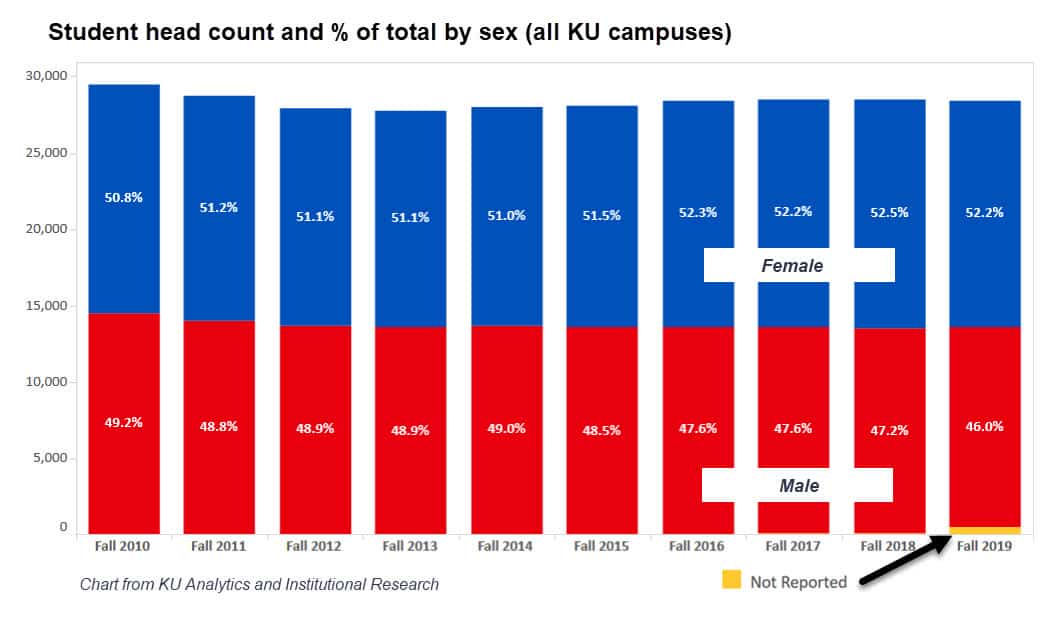
Men accounted for 46% of KU students this fall, the lowest percentage of the decade. The number of men enrolling at KU has declined from 49.2% in 2010, reflecting a national trend of fewer men going to college.
The number of students not reporting gender spiked this year to 524 from 75 in Fall 2018, 53 in Fall 2017 and 25 in Fall 2016. This reflects a national trend of students more willing to identify as gender fluid, transgender or non-binary.
Interestingly, the vast majority of those who did not report gender were graduate students. The breakdown of graduate students this fall is 50.6% women, 40.4% men and 9% not listing gender.
Other changes in student demographics
Several other changes in the characteristics of students are worth noting:
- Declining number of transfer students.Transfer students have never made up a large percentage of the student population at KU, but their numbers have fallen significantly during the past decade. In Fall 2010, the Lawrence campus reported 1,404 transfer students, compared with 1,024 this fall. That is a decline of 27%.
- Declining number of graduate students. The Lawrence campus has 5,570 graduate students this fall, a decline of 9.5% since 2016 and 13.5% since 2010. This is largely a result of a smaller number of students pursuing a master’s degree (down 19.8% since 2010), although the number of doctoral students has declined 9.1% from a peak in 2013.
- Declining number of international students. The number of international students fell for the fourth straight year and is now 14% below a peak of 2,363 in Fall 2015. This again follows a national trend.
- Rising number of Hispanic students. The number of Hispanic students attending KU has increased 65% since 2010, with growth in every year this decade. Hispanic students now make up 8% of the student body. This again reflects national trends.
- Rising number of part-time students. The number of part-time students on the Lawrence and Edwards campuses surpassed 4,000 for the first time this fall. Part-time students now account for 16.3% of the total student population, the highest percentage this decade and up from 13.7% in 2012.
Changes at Edwards Campus
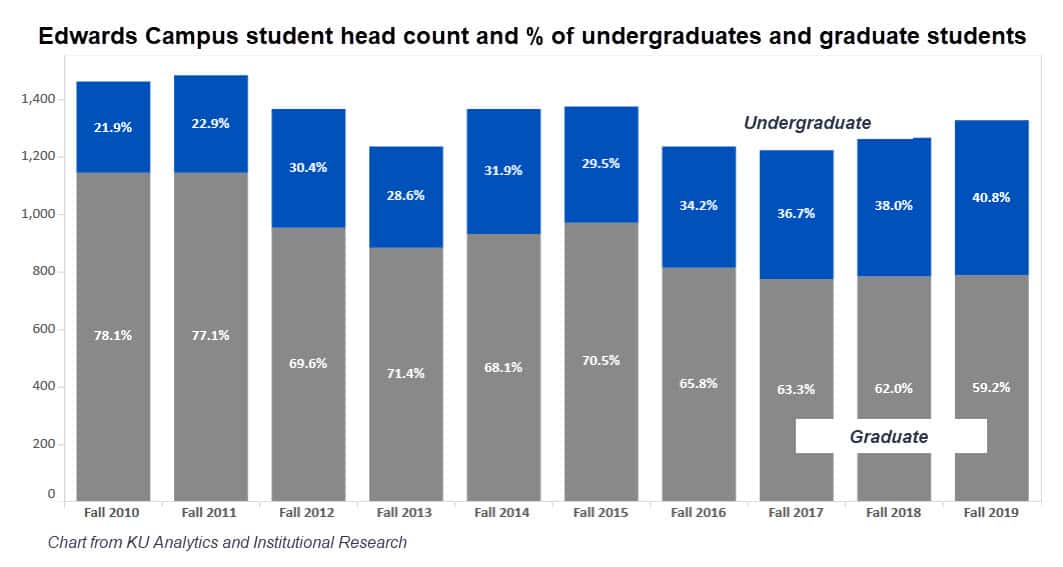 KU’s Edwards Campus has traditionally been reliant on professional master’s programs for its enrollment. That has begun to shift toward more of a balance of graduate and undergraduate programs.
KU’s Edwards Campus has traditionally been reliant on professional master’s programs for its enrollment. That has begun to shift toward more of a balance of graduate and undergraduate programs.
Undergraduates now account for nearly 41% of students at the Edwards campus, nearly double the percentage of a decade ago. That is an enormous shift in mission and mentality. The campus is still heavily reliant on working professionals who attend evening classes, but it has increased its online offerings, partnered with Kansas City-area schools and businesses, and drawn undergraduates to programs like information technology, molecular biosciences and exercise science.
A national conversation on evaluating teaching starts to take shape
A recent meeting at the National Academies of Sciences, Engineering and Medicine achieved little consensus on how best to evaluate teaching, but it certainly showed a widespread desire for a fairer system that better reflects the many components of excellent teaching.
The National Academies co-sponsored the meeting earlier this month in Washington with the Association of American Universities and TEval, a project associated with the Center for Teaching Excellence at KU. The meeting brought together leaders from universities around the country to discuss ways to provide a richer evaluation of faculty teaching and, ultimately, expand the use of practices that have been shown to improve student learning.

My colleague Andrea Greenhoot, professor of psychology and director of CTE, represented KU at the meeting. Members of the TEval team from the University of Massachusetts, Amherst, the University of Colorado, Boulder, and Michigan State University also attended. The TEval project involves more than 60 faculty members at KU, CU and UMass. It received a five-year, $2.8 million grant from the National Science Foundation last year to explore ways to create a fairer, more nuanced approach to evaluating teaching.
The TEval project, which is known as Benchmarks at KU, has helped put KU at the forefront of the discussion about evaluating teaching and adopting more effective pedagogical strategies. Nine departments have been working to adapt a rubric developed at CTE(Link does not exist), identify appropriate forms of evidence, and rethink the way they evaluate teaching. Similar conversations are taking place among faculty at CU and UMass. One goal of the project is to provide a framework that other universities can follow.
Universities have long relied on student surveys as the primary – and often sole – means of evaluating teaching. Those surveys can gather important feedback from students, but they provide only one perspective on a complex process that students know little about. The results of the surveys have also come under increasing scrutiny for biases against some instructors and types of classes.
Challenges and questions
The process of creating a better system still faces many challenges, as speakers at the meeting in Washington made clear. Emily Miller, associate vice president for policy at the AAU, said that many universities were having a difficult time integrating a new approach to evaluating teaching into a rewards system that favors research and that often counts teaching-associated work as service.
“We need to think about how we recognize the value of teaching,” Miller said.
She also summarized questions that had arisen during discussions at the meeting:
- What is good teaching?
- What elements of teaching do we want to evaluate?
- Do we want a process that helps instructors improve or one that simply evaluates them annually?
- What are the useful and appropriate measures?
- What does it mean to talk about parallels between teaching and research?
- How can we situate the conversation about the evaluation of teaching in the larger context of institutional change and university missions?
Noah Finkelstein, a University of Colorado physics professor who is a principal investigator on the TEval grant, brought up additional questions:
- How do we frame teaching excellence within the context of diversity, equity and inclusion?
- How can we create stronger communities around teaching?
- How do we balance institutional and individual needs?
- How do we reward institutions who improve teaching?
- When will AAU membership be contingent on teaching excellence?
Moving the process forward
Instructors at KU, CU and UMass are already grappling with many of the questions that Miller and Finkelstein raised.
At KU, a group will meet on Friday to talk about the work they have done in such areas as identifying the elements of good teaching; gathering evidence in support of high-quality teaching practices; developing new approaches to peer evaluation for faculty and graduate teaching assistants; providing guidance on instructor reflection and assessment; and making the evaluation process more inclusive. There have also been discussions among administrators and Faculty Senate on ways to integrate a new approach into the KU rewards structure. Considerable work remains, but a shift has been set in motion.
KU faculty and staff share insights on teaching
Several KU faculty members have recently published articles about their inquiry into teaching. Their articles are well worth the time to read. Among them:
- Patterns in curricula. Josh Potter, the documenting learning specialist at CTE, writes in Change magazine about a model he has created for showing how students move through classes in a curriculum.
- Physics. Sarah LeGresley Rush, Jennifer Delgado, Chris Bruner, Michael Murray, and Chris Fischer write about their work in rethinking introductory physics. Their paper, published in Physical Review Physics Education Research, was also featured in the online magazine of the American Physical Society.
- Journalism. Carol Holstead, associate professor of journalism and mass communications, writes about the importance of learning students’ names. Her article appeared in The Chronicle of Higher Education.
- Music therapy. Abbey Dvorak, associate professor of music therapy, writes in the Journal of Music Therapy about using a research assignment that involves an entire class pursuing a single question. She also explains the approach in a video.
- History. Tony Rosenthal, professor of history, writes in The Journal of Urban History about an interdisciplinary journey he took in creating assignments and materials for an undergraduate history course called Sin Cities.
Briefly …
- Writing in EdSurge, Bryan Alexander says that “video is now covering a lot of ground, from faculty-generated instructional content to student-generated works, videoconferencing and the possibility of automated videobots.” The headline goes beyond anything in the article, but it nonetheless raises an interesting thought: “Video assignments are the new term paper.”
- The Society for Human Resource Management writes about a trend it calls “microinternships,” which mirror the work of freelancers. Microinternships involve projects of 5 to 20 hours that the educational technology company Parker Dewey posts on a website. Students bid on the work, and Parker Dewey takes a percentage of the compensation. The company says it is working with 150 colleges and universities on the microinternship project.
- Writing in The Chronicle of Higher Education, Aaron Hanlan argues that by relying on a growing number of contingent, “disposable” instructors, “institutions of higher education today operate as if they have no future.” In following this approach, tenured faculty and administrators “are guaranteeing the obsolescence of their own institutions and the eventual erasure of their own careers and legacies,” he argues.
- EAB writes about the importance of reaching out to students personally, saying that email with a personal, supportive tone can be like a lifeline to struggling students.
Peer learning expands as instructors remake courses
Watching David Johnson’s class in digital logic design is a bit like watching synchronized swimming.
After a few minutes of announcements, Johnson and half a dozen GTAs and undergraduate teaching fellows fan out across an Eaton Hall auditorium as 60 or so students begin to work on problems that Johnson has assigned.
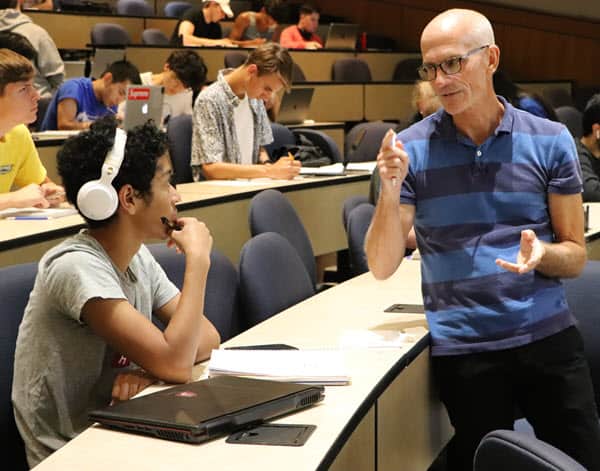
A hand goes up on one side of the room. Johnson approaches, and students around him listen intently as he asks questions and quietly offers advice. Across the aisle, a group of four young men confers about the problem, looking things up on laptops, writing down notes by hand, erasing, writing again, and sharing ideas. A few rows ahead, two young women point at the problem on the screen at the front of the room. They confer, take notes, and confer more. Across the room, hands go up and, one by one, the class assistants approach, offer their help and then search for more raised hands.
“We’re always busy helping someone,” Johnson said.
Similar scenes have increasingly played out across the university – and across the country – as a growing number of instructors, primarily in STEM fields, have hired undergraduate teaching assistants to work in their classes. The undergrad TAs are just one example of how colleges and universities have elevated the importance of peer learning as part of their efforts to retain students and to help them move toward graduation.
Many educational roles
At KU, those efforts extend into many areas. First-Year Experience, honors, pharmacy and business are among the programs that use peer mentors. The Undergraduate Advising Office has a team of peer advisors who, among other things, help students navigate choices of classes and majors, and help them find campus resources. As anxiety and depression have increased among students, Counseling and Psychological Services has created a peer educator program to work with students on mental health.
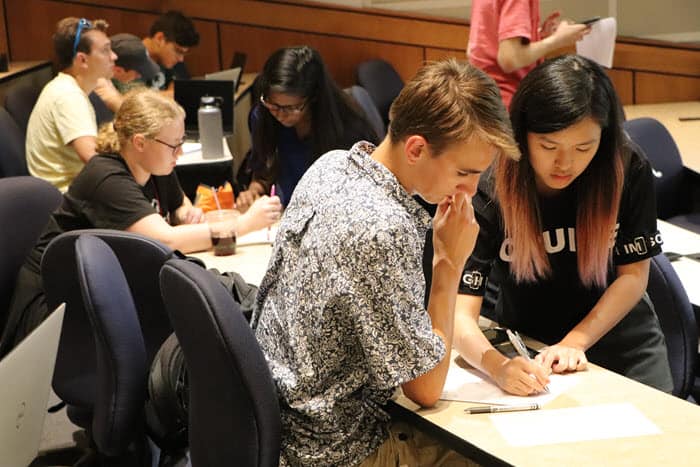
The university’s Supplemental Instruction program is also growing and now has peer leaders working with two dozen courses. Those peer leaders have successfully completed the course they are helping with. They lead sessions in which students review course material, prepare for exams, work on study skills, and offer support to one another throughout a semester. That approach, which started at the University of Missouri-Kansas City, has been found to improve grades, retention rates and, ultimately, graduation rates.
Peers have always played a role in learning, and they have long been involved in writing programs, tutoring and review sessions. The use of large numbers of undergraduate assistants in classes is relatively new, though, and is tied to a growing use of flipped classes, active learning, and in-class problem-solving. Over the past five years or so, KU instructors in such fields as geology, biology, chemistry, physics, and engineering have hired undergraduate assistants to work in their largest classes. Those assistants do such things as monitor online discussion boards, help with labs, proctor exams, and hold office hours. A pre-semester training program was started two years ago for undergraduate assistants in STEM courses, allowing the assistants and instructors to gain a better understanding of how to work together.
Undergraduate assistants have been crucial in transforming large lecture courses into hubs of active learning. Coordinating with instructors and graduate teaching assistants, they monitor groups or sections of a classroom, answer questions, offer praise, and through their interactions with students, make large courses more personal. Like students who lead Supplemental Instruction sessions, the undergraduate assistants in large classes have recently taken the course, so they understand the flow of the class, the course material, and the areas where students are most likely to struggle.
As they help their peers, they hone their own understanding of course material, improve their communication skills, and gain experience working with groups of people. That deeper understanding helps prepare them for upper-level classes as well as medical school exams, internships and graduate school. Most rely on the money they earn to help pay their college bills. Nearly all report a sense of satisfaction from the experience.
“When you see someone finally get it, it’s really cool,” one undergraduate assistant said at a recent training session.

Zero lecture time
Johnson has used graduate teaching assistants, Supplemental Instruction assistants, and undergraduate teaching fellows (as the assistants are known in engineering) to make dramatic changes in his classes. With the help of Molly McVey, a post-doctoral teaching fellow in engineering, Johnson flipped a course in which he was lecturing about half of class time. They created online materials that helped students prepare for in-class problem-solving and hired undergraduate fellows to help in the classroom. When the flipped version debuted last year, lecture time had dropped to nearly zero.
“The only time they really hear me speak is if I have an announcement, usually to remind them of a test,” Johnson said.
Johnson first tried the flipped approach during a summer computer science camp for high school students, and he was surprised by how much more students learned. So he began to transform EECS 140, which he described as a gateway course required of all students in electrical engineering. He received a course transformation grant from the Center for Teaching Excellence and worked with course designers and video specialists at the Center for Online and Distance Learning to create online materials. He had the undergraduate assistants create the in-class problems, which he described as “nearly perfect” because they require considerable thought but can still be completed during class time.
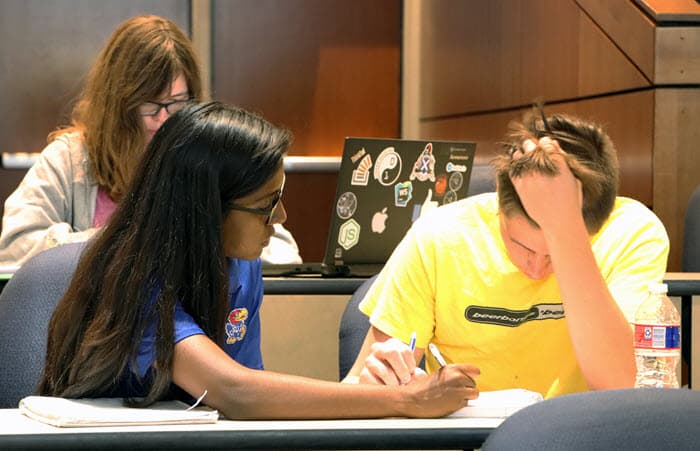
During the first week, students aren’t sure what to make of the hands-on approach, but that hesitancy quickly disappears as they adapt to the in-class problem-solving.
“The first class they were just sitting there waiting,” Johnson said. “I explained to them again that they could start working. By the third or fourth class, they were already asking questions even before the class started.”
The questions continue throughout the class period, and Johnson and the student assistants are constantly on the move. The constant interaction has helped Johnson better connect to the class.
“When I walk around and talk to students, I really understand what they don’t understand,” Johnson said. “That really helps me do a better job.”
Students are free to leave class once they complete the day’s problems, but many stay for the entire period. Some who finish early work on the next online module, knowing they can get help if they have questions. Others like to stay and help their peers.
Improved learning and a sense of satisfaction
Learning has improved significantly in many areas of the class, and the number of students who drop or fail has fallen. The approach isn’t perfect. Johnson said there was a dip in some areas on the last of the four exams he gives. By the end of the semester, though, many students know that their grades won’t change much regardless of how they do on the last exam, so they don’t approach that exam with the same seriousness they do earlier work, Johnson said.
During class, though, the students are focused and engaged. A hand goes up at the back. An undergraduate teaching fellow kneels, listens and offers advice. A hand goes up in front, in the center, on the far side of the room. Johnson moves from table to table, student to student.
“Students always think it’s easy for an instructor to do that,” Johnson said. “For me, it’s a lot harder to go around and explain something to someone who doesn’t understand some things than it is to just stand up there and flap away and hope they understand. It takes a lot more energy out of me, but I feel much better at the end of class when I think, ‘Wow, I really did teach somebody something.’ ”
Moving higher education from storied past to innovative future
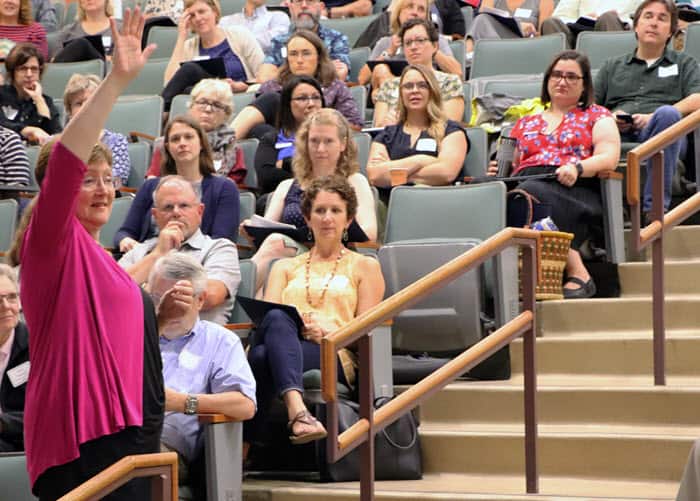
We know the story well. We helped write it, after all.
As instructors and students and administrators, we have lived the story of modern higher education. And yet, despite the familiarity of that story – or perhaps because of it – we continue to struggle with its meaning and direction.
Ann Austin, an education professor and administrator at Michigan State, told participants at KU’s annual Teaching Summit last week that that struggle is not only natural; it is also crucial as colleges and universities adapt to a landscape that has changed dramatically over the past 20 years and is poised to change even more dramatically in the next 20.
In her Summit keynote address, Austin moved among the past, present and future as she highlighted the challenges and opportunities that rapid societal changes are posing to colleges and universities. She also challenged faculty members and administrators to think philosophically and creatively about the way they teach, interact and plan.
“What kind of vision do we have in the back of our minds as we go about our day-to-day work?” Austin asked.
“What is our vision for where our learners are going, and what is our vision for the role we play in their lives?”
That vision, after all, guides us in conscious and unconscious ways, and is crucial for the success of the university. We are doing many good things, she said, but we need to be more creative in working with students, curricula and our approach to learning.
‘This noble profession’
Austin maintained an upbeat tone as she made a case that colleges and universities must change to keep pace with society. Universities are exemplars of society, places to share ideas, to advance knowledge and to debate with respect, she said. She evoked the symbolism of KU’s campus on a hill as an indication that it is “involved in something important,” or what she called “this noble profession.”

Even so, those of us who teach and work and learn and lead at universities must push our institutions to adapt and evolve. We have welcomed an increasingly diverse population of students, Austin said, and we must find better ways to support those students. Right now, she said, there’s a mismatch between social needs and educational practices and outcomes. (There is also a growing political rift over the direction of higher education.) We are doing much good, she said, but we need to do more.
“How do we create environments for the success of all?” Austin asked.
She pointed to large gateway classes as an example of where universities have fallen short. Those courses can guide students toward many types of careers – or prevent them from pursuing those careers. Nationally, half of students in those courses fail, she said, and women and students of color encounter the biggest hurdles. By embracing evidence-based teaching practices and taking a more inclusive approach to teaching and learning, though, we can lower the barriers to success.
“We know that if we change the way we go about our teaching, if we think about what will support this diversity of learners, we can pretty much get rid of that gap,” she said, citing years of research about active and engaged learning.
‘Generosity of thinking’ and other any areas of potential
Gateway courses are just one area where there is a mismatch between social needs and educational practices and outcomes, she said. Another involves soft skills, or what Austin calls “human skills”: things like communicating well; discerning between accurate and inaccurate information; understanding the context of problems and actions; engaging in teamwork and collaboration; and approaching work with integrity and ethical standards.

She also singled out something she called “generosity of thinking,” or the ability to work with people different from yourself and to seek out those complementary perspectives on projects at work and in communities.
“We really need to cultivate that even more than perhaps we do,” Austin said.
Austin drew upon her work as co-chair of the Roundtable on Systemic Change in Undergraduate STEM Education for the National Academies of Science, Engineering and Medicine. That group has highlighted the importance of a vibrant educational system and a well-educated citizenry that can join conversations on the challenges facing society. It has also focused on the needs of a changing workforce.
We know that jobs that are common today won’t exist in the future, Austin said. And in 10 or 20 years, “there will be opportunities for work that we can’t even imagine right now.”
“How do we prepare our students for this kind of world?” she asked.
What can we do?
I’ve written before about Austin, who cofounded the Center for Integration of Research, Teaching, and Learning. Her work in organizational change has influenced some of the approaches we take at CTE, and she is a partner on a National Science Foundation grant on creating a more nuanced approach to evaluating teaching. She has worked with many KU faculty members on that project, which is known as Benchmarks for Teaching Effectiveness at KU. The multi-university project is known as TEval.
Austin provides broad insight and thought-provoking questions to everything she does, and the Summit was no exception. She also offered several concrete steps that participants could take to improve their courses, their departments and the learning environments for their students:
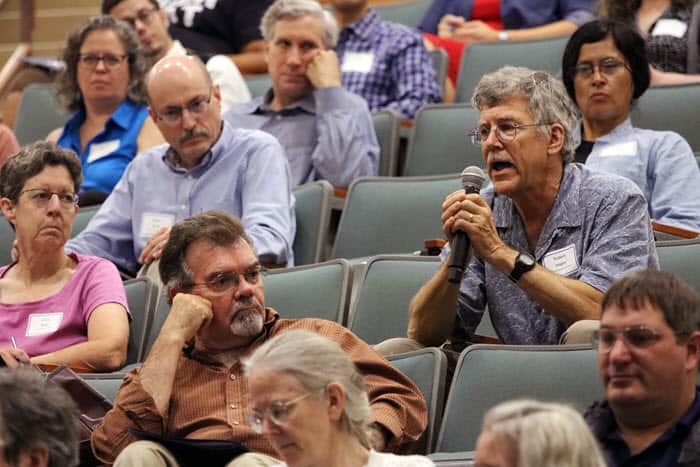
- Embrace high-impact practices. These include things like service learning, internships, writing-intensive courses, and learning communities. These and other practices “link the knowing with the doing,” Austin said, and create a more equitable learning environment.
- “Become more fluent in how learning happens.” Research into learning and higher education continually provides new insights, Austin said, urging participants to consider ways of applying that research in their disciplines. CTE programs and materials can help instructors do that without spending hours combing through journals.
- Focus on learning, not seat time. Our courses are organized by credit hours, a system that originated in the 19th century and focused on the amount of time instructors delivered information to students. That system is outmoded, especially for online courses, but we can still work within it, Austin said, by emphasizing learning and using effective means of assessing learning.
- Seek out new ways to reach students. This might involve using technology, taking an innovative approach in face-to-face or online courses or curricula, or using new types of physical classrooms. Austin emphasized the importance of flexibility and creativity in helping students learn. Organize curricula in new ways and look for new pathways that better fit today’s students. She said that included not just degrees but ways for people to move in and out of higher education to refresh skills and share their expertise.
- Cultivate new partnerships. Communities inside and outside the university help us draw on new perspectives, learn from one another, and create new learning opportunities for our students and our colleagues. These partnerships can also provide opportunities for developing and promoting leadership skills that universities need if they hope to innovate.
Even as she pushed audience members to take action, she urged them to draw on the many good things already happening at universities.
“I’m not in any way suggesting that we just jettison what we’re doing,” Austin said. “We do so much that is so good.”
Rather, she suggested committing to effective practices and ask “what is this changing world suggesting that we might do differently?”
Doing so helps us move from story – a beacon on a hill in a volatile, changing world – to action.
“That’s the story we are part of,” Austin said. “We need to think not only in a philosophical way – that’s part of the story – but in a real practical way. What do we do in our departments, in our programs and in the university to actually let us make the best contributions to our learners and to society?”
A cloudy day with lots of sunshine
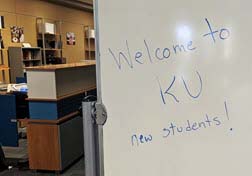
The Summit took place on the same day that hundreds of students moved in to KU’s residence halls. Chancellor Doug Girod, dressed in khaki slacks and a blue KU polo shirt, said at the beginning of the Summit that he always looked forward to helping with the move-in and talking with students and their families.
The day was cloudy, and the sky threatened rain, but school had yet to start and a shiny eagerness and a positive energy permeated the campus.
“This is one of the few days of the year when everybody smiles,” Girod said.
Doug Ward is the associate director of the Center for Teaching Excellence and an associate professor of journalism. You can follow him on Twitter @kuediting.
Using data to better understand student ‘grade surprise’
A colleague’s daughter recently finished her first year of college. In high school, he said, she had never really had to study to get good grades. In college, though, she had to adjust her study habits and her thinking after her early grades dipped below the A’s and B’s she had routinely – and easily – received.
That sort of dip in grades is common among traditional freshmen as they learn to live away from home for the first time, deal with the liberation and temptations of personal independence, and try to make sense of the academic expectations of college. How they deal with that jolt can affect everything from their choice of majors to their ability to stay in college.
Jennifer Meta Robinson, an anthropology professor at Indiana University-Bloomington, has been studying this phenomenon, which she calls “grade surprise.” Students usually have a good sense of the grades they will receive on assignments or exams, or in a class. When that expectation doesn’t match reality, though, they experience grade surprise.
Robinson explained her research

to the steering committee of the Bay View Alliance earlier this month in Bloomington, Indiana. Both Indiana and KU are members of the Bay View Alliance, a consortium of 10 research-intensive universities that are working to elevate teaching and improve learning among students. Robinson and colleagues in chemistry, computer science and informatics recently received a mini-grant from the Association of American Universities to continue their work of surveying students and analyzing university data to try to find questions they have about grade surprise among students:
- How does grade surprise affect retention in various majors?
- Does the power of grade surprise grow as students move through additional classes?
- What approaches help students recover when they encounter grade surprise?
Robinson’s hypothesis is that grade surprise impedes student progress but can be mitigated. When students are overconfident, she said, failure is more painful than when they have low expectations about their grades. “Surprise creates pain,” Robinson said. She is also looking at the flip side of that: whether there is positive grade surprise. “There’s a human tendency to rewrite the past,” she said. “We mitigate our pain by retelling our story in a way that makes it less surprising.” For instance, students might tell themselves that a low grade was the instructor’s fault or that people like them just don’t do well with this type of material or in these types of classes. That type of thinking can easily push students out of classes or majors. Interestingly, few students seem to blame instructors when grades come in lower than expected. “We were surprised at how few students said, ‘The teacher had it in for me,’” Robinson said. “Or, ‘This was out of left field. I studied this other thing and it wasn’t on the test.’ There was very little of that. It really was about more about what I can do, what I practice, where I can spend more time. The locus of control was within.”
Disparities in distribution and reaction
Grade surprise isn’t equally distributed, Robinson said. Underrepresented minority students and first-generation students are more likely to be surprised by their grades. And women feel more disappointment when they receive lower grades.
Robinson and her colleagues have been sharing context about grades to try to ease some of the pain of grade surprise. For instance, in computer science and informatics classes at Indiana, women generally receive higher grades than men. In chemistry, women and men receive similar grades, although all receive lower grades than they did in high school.
“So women may feel that more, that disappointment in themselves, that setback of, ‘Oh, maybe I don’t belong,’” Robinson said. “But that’s where we could say to them that they may be processing this differently but the GPA facts of it are that they are doing the same.”
An analysis of data at Indiana shows that many students bounce back after the shock of an initial grade. They expect an A, receive a C but then eventually get an A in the course. Robinson and her colleagues want to better understand what students do to recover. They are also looking at the mindset of students who think they did poorly on, say, a midterm exam but actually did well. What happens if they enroll for the subsequent semester before they know their grade?
“What is that little detour through the course?” she asked. “How long does that hang in the air that you think you’ve bombed but you get that assignment back and got that A after all?”
A move toward wider use of data
Robinson describes the grade surprise project as one of many that “connect classes to the potential of big data.” Indiana has an ambitious program in helping faculty members combine university demographic data with data about student performance in classes. That combination is often referred to as learning analytics. The Indiana program, known as Learning Analytics Fellows, has led to more than 50 projects since it started in 2015. It is run through a recently created Center for Learning Analytics and Student Success.
We have been working on a similar project at KU, though at a smaller scale. An AAU mini-grant through the Center for Teaching Excellence has allowed several STEM departments to use university data to learn more about their students and about the paths they take through various curricula. The recently created Office of Analytics and Institutional Research (formerly the Office of Institutional Research and Planning) has continued the momentum around wider application of university data. One of its divisions focuses on academic data analytics and is looking at ways of making more data available to faculty members.
These types of data project allow instructors and departments to ask new questions about curricula, with an eye toward improving student retention and graduation rates. As Robinson explained in her talk at Indiana, this use of data is driving culture change as universities find ways to scale learning analytics even as they explore the potential of data in education. Robinson emphasized the importance of providing context for data and of applying “interpretive muscle” to tease out insights.
“These are drivers for change at all of our universities,” she said.
A student view of effective teaching
AUSTIN, Texas – How do students view effective teaching?
They offer a partial answer each semester when they fill out end-of-course teaching surveys. Thoughtful comments from students can help instructors adapt assignments and approaches to instruction in their classes. Unfortunately, those surveys emphasize a ratings scale rather than written feedback, squeezing out the nuance.

To address that, staff members from the Institute for Teaching and Learning Excellence at Oklahoma State spoke with nearly 700 students about the effectiveness of their instructors and their classes. They compiled that qualitative data into suggestions for making teaching more effective. Christina Ormsbee, director of the center at OSU, and Shane Robinson, associate director, shared findings from those surveys last week at the Big 12 Teaching and Learning Conference in Austin.
Here are some of the things students said:
- Engage us. The students’ favorite instructors vary their approach to class, use interesting and engaging instructional methods, and use relevant examples.
- Communicate clearly. Students value clear assignments, transparent communication, and timely, useful feedback. They also want lecture notes posted online.
- Be approachable. Students described their favorite instructors as personable, professional and caring. “Students really want faculty to care about them,” Ormsbee said. They also want instructors to care about student learning. They complained about instructors who were abrasive, sarcastic or demeaning.
- Align class time with assessments. Students want instructors to respect their time by using class activities and lessons that connect to out-of-class readings and build toward assessments.
- Be available. Students want instructors to hold office hours at times that are convenient for students and to help them when they ask. They also expect instructors to communicate through the campus learning management system and though email and other types of media.
- Be organized. Students appreciate organizational tools like detailed class agendas and timelines. They like study sessions before exams, but they also want instructors to go over material they missed on exams.
- Slow down. Students say instructors often go through course material too quickly.
- Grade fairly. Students dislike instructors who focus grading too heavily on one aspect of a course, grade too harshly, or deduct points for missing class or for not participating.
- Don’t give us too much work. (You aren’t surprised, are you?)
Much of this aligns with the research on effective teaching and learning (engagement, alignment, organization, pacing, transparency, clarity). Some of it also aligns with aspects of universal design for learning (see below). Other aspects have as much to do with common courtesy as with good pedagogy. (We all want to feel respected.) Still other parts reflect a consumer mentality that has seeped into many aspects of higher education.
Feedback from students is important, but it is also just one of many things that instructors need to focus on. A class of satisfied students means nothing if none of them is learning. And students know little about the years of accumulated evidence about effective teaching. So we should listen, yes, but we should base decisions about our classes on an array of evidence and thoughtful reflection.
Universal design takes center stage
All too often, instructors, administrators and staff members think about accessibility of course content only when a student requests an accommodation.
The problem with that approach, said Melissa Wong of the University of Illinois at Urbana-Champaign, is that a vast majority of students who need accommodations never seek them out. Sometimes they don’t know about a disability or have never been formally diagnosed. In other cases, students are embarrassed about having to share personal details or assume they can make it through a class without an accommodation.
Wong called the current system of acquiring an accommodation “legalistic.” Students must have health insurance. They must fill out multiple forms and have records transferred. They must maneuver through university bureaucracy and find the right offices, a skill that many students lack. Then they must submit forms in each class they take. In class, they may confront inaccessible course materials, hazy expectations, and daunting assignments.
Each of those barriers adds to students’ burden, ultimately making things harder for instructors and for other students. Instructors can help all their students – even those who don’t need accommodations – by following the principles of universal design for learning, though, Wong said. Wong was among several speakers at the Big 12 conference who emphasized the importance of universal design for learning.
Universal design started with architecture (think curb cuts and self-opening doors), but its importance in education has grown as the diversity of students has grown. In essence, it is a way of thinking about learning in terms of student choices: multiple forms of engagement, multiple means of representation, and multiple forms of action and expression.
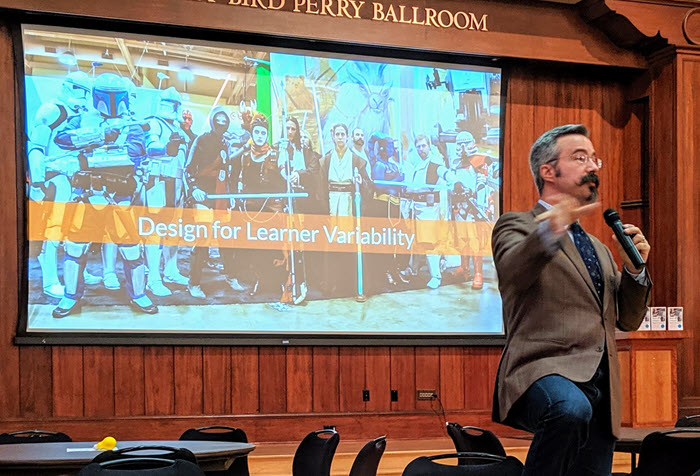
Tom Tobin of the University of Wisconsin-Madison suggested thinking of universal design in terms of “plus one.” If you have a written assignment, consider giving students one other option for completing the same work. If you provide a video, make sure it has captions.
“We don’t have to perfect,” Tobin said. “We just have to be good."
He also suggested reframing the conversation about accessibility to one about access. Good access helps all students learn more effectively and keeps them moving toward graduation.
“The idea of UDL is not to lower the rigor of the material,” Tobin said. “The idea is to lower the barrier of getting into the conversation in the first place.”
Wong offered some additional advice on how to apply universal design in classes:
- Use a clear organizational structure in your syllabus. Use subheads so that students can find everything easily. And make sure the syllabus has a section on accommodations.
- Create a list of assignments and due dates. This helps students plan and cuts down on anxiety. Wong said a one-page assignment calendar she creates was one of the most popular things she had done for her classes.
- Present information in a variety of ways (text, video, audio, multimedia), and provide examples of successful work. Offering choices in assignments can help students feel more in control and allow them to demonstrate learning in ways they are most comfortable with. For instance, you might give students a range of assignment topics to choose from and give them options like video or audio for presenting their work, in addition to writing.
- Make sure video is close-captioned. If you have audio, make sure students have access to a transcript.
- Use a microphone routinely, especially in large classrooms.
- Scaffold assignments so that students can work toward a goal in smaller pieces.
- Be flexible with deadlines. If you give one student an extension, make sure all students have the same option. If a student is chronically late with assignments or frequently seeks to make up work, try to understand the underlying problems and refer that student to offices on campus that can help.
The best approach is to take accessibility into account from the beginning rather than trying to retrofit things later, Wong said. That not only cuts down on the need for accommodations but creates a smoother route for all students.
Other nuggets from the conference:
Supplemental instruction success. A three-year study at the University of Texas-Austin found that student participation in supplemental instruction sessions improved grades in gateway courses in electrical engineering. Supplemental instruction involves regular student-led study sessions overseen by trained student facilitators. About 40% of students in UT’s Introduction to Electrical Engineering courses participated in supplemental instruction. I’ll be writing more about KU’s supplemental instruction program in the next few weeks.
Practical thinking. Shelley Howell of the University of Texas-San Antonio emphasized the importance of relevance in helping students move toward deeper learning. She drew on a model from Ken Bain’s book What the Best College Students Do, categorizing students into surface learners (who do just enough to get by), strategic learners (who focus on details and stress about grades) and deep learners (who are curious and ask questions, accept failure as a part of the learning process, and apply learning across disciplines). All students need to understand the purpose of individual assignments, and instructors need to make course content relevant, give students choices, and ask questions that take students on a “messy” path to understanding, Howell said.
Red alert. Educators have grown too complacent about student failure, Howell said, and would benefit from a Star Trek approach to student success. Every episode of Star Trek is essentially the same, she said: Something goes wrong. The problem must be fixed right away or the ship will crash. The problem is impossible to fix. The crew finds a way to fix it anyway. What if those of us in higher education had the same attitude? Howell asked, adding: If you knew that every student had to succeed, how would you teach differently?
A final thought. Emily Drabinski, a critical pedagogy librarian at the Graduate Center at City University of New York, offered this bit of wisdom: “For knowledge to be made, it has to be organized.”
A teaching event grows into a celebration
When we started an end-of-semester teaching event four years ago, we referred to it simply as a poster session.
The idea was to have instructors who received grants from the Center for Teaching Excellence or who were involved in our various programs create posters and then talk with peers and visitors as they might at a disciplinary conference. In this case, though, the focus was on course transformation and on new ways that instructors had approached student learning.
As the event grew, we decided to call it the Celebration of Teaching, and it has become exactly that.
We didn’t do an official count at the event on Friday, but well more than 100 people attended. There were 54 posters created by instructors involved in Diversity Scholars, the Curriculum Innovation Program, and the Best Practices Institute, and those who received course transformation grants during the year.
Here’s view of the Celebration of Teaching in photographs.
4 ways to increase participation in student surveys of teaching
If you plan to use student surveys of teaching for feedback on your classes this semester, consider this: Only about 50% of students fill out the surveys online.
Yes, 50%.
There are several ways that instructors can increase that response rate, though. None are particularly difficult, but they do require you to think about the surveys in slightly different ways. I’ll get to those in a moment.
The low response rate for online student surveys of teaching is not just a problem at KU. Nearly every university that has moved student surveys online has faced the same challenge.
That shouldn’t be surprising. When surveys are conducted on paper, instructors (or proxies) distribute them in class and students have 10 or 15 minutes to fill them out. With the online surveys, students usually fill them out on their own time – or simply ignore them.
Response rates on teaching surveys at KU, 2015-2018
Student participation in end-of-semester teaching surveys has fallen as the surveys have moved online. Many instructors still report rates of 80% to 100%, but overall rates range between 50% and 60%. These rates reflect only the surveys that were taken online.
I have no interest in returning to paper surveys, which are cumbersome, wasteful and time-consuming. For example, Ally Smith, an administrative assistant in environmental studies, geology, geography, and atmospheric sciences, estimates that staff time needed to prepare data and distribute results for those four disciplines has declined by 47.5 hours a semester since the surveys were moved online. Staff members now spend about 4 hours gathering and distributing the online data.
That’s an enormous time savings. The online surveys also save reams of paper and allow departments to eliminate the cost of scanning the surveys. That cost is about 8 cents a page. The online system also protects student and faculty privacy. Paper surveys are generally handled by several people, and students in large classes sometimes leave completed surveys in or near the classroom. (I once found a completed survey sitting on a trash can outside a lecture hall.)
So there are solid reasons to move to online surveys. The question is how to improve student responsiveness.
I recently led a university committee that looked into that. Others on the committee were Chris Elles, Heidi Hallman, Ravi Shanmugam, Holly Storkel and Ketty Wong. We found no magic solution, but we did find that many instructors were able to get 80% to 100% of their students to participate in the surveys. Here are four common approaches they use:
Have students complete surveys in class
Completing the surveys outside class was necessary in the first three years of online surveys at KU because students had to use a laptop or desktop computer. A system the university adopted two years ago allows them to use smartphones, tablets or computers. A vast majority of students have smartphones, so it would be easy for them to take the surveys in class. Instructors would need to give notice to students about bringing a device on survey day and find ways to make sure everyone has a device. Those who were absent or were not able to complete the surveys could still do so outside class.
Remind students about the surveys several times
Notices about the online surveys are sent by the Center for Online and Distance Learning, an entity that most students don’t know and never interact with otherwise. Instructors who have had consistently high response rates send out multiple messages to students and speak about the surveys in class. They explain that student feedback is important for improving courses and that a higher response rate provides a broader understanding of students’ experiences in a class.
To some extent, response rates indicate the degree to which students feel a part of a class, and rates are generally higher in smaller classes. Even in classes where students feel engaged, though, a single reminder from an instructor isn’t enough. Rather, instructors should explain why the feedback from the surveys is important and how it is used to improve future classes. An appeal that explains the importance and offers specific examples of how the instructor has used the feedback is more likely to get students to act than one that just reminds them to fill out the surveys. Sending several reminders is even better.
Give extra credit for completing surveys
Instructors in large classes have found this an especially effective means of increasing student participation. Giving students as little as 1 point extra credit (amounting to a fraction of 1% of an overall grade) is enough to spur students to action, although offering a bump of 1% or more is even more effective. In some cases, instructors have gamified the process. The higher the response rate, the more extra credit everyone in the class receives. I’m generally not a fan of extra credit, but instructors who have used this method have been able to get more than 90% of their students to complete the online surveys of teaching.
Add midterm surveys
A midterm survey helps instructors identify problems or frustrations in a class and make changes during the semester. signaling to students that their opinions and experiences matter. This in turn helps motivate students to complete end-of-semester surveys. Many instructors already administer midterm surveys either electronically (via Blackboard or other online tools) or with paper, asking students such things as what is going well in the class, what needs to change, and where they are struggling. This approach is backed up by research from a training-evaluation organization called ALPS Insights, which has found that students are more likely to complete later course surveys if instructors acknowledge and act on earlier feedback they have given. It’s too late to adopt that approach this semester, but it is worth trying in future semesters.
Remember the limitations
Student surveys of teaching can provide valuable feedback that helps instructors make adjustments in future semesters. Instructors we spoke to, though, overwhelmingly said that student comments were the most valuable component of the surveys. Those comments point to specific areas where students have concerns or where a course is working well.
Unfortunately, surveys of teaching have been grossly misused as an objective measure of an instructor’s effectiveness. A growing body of research has found that the surveys do not evaluate the quality of instruction in a class and do not correlate with student learning. They are best used as one component of a much larger array of evidence. The College of Liberal Arts and Sciences has developed a broader framework, and CTE has created an approach we call Benchmarks for Teaching Effectiveness. It uses a rubric to help shape a more thorough, fairer and nuanced evaluation process.
Universities across the country are rethinking their approach to evaluating teaching, and the work of CTE and the College are at the forefront of that. Even those broader approaches require input from students, though. So as you move into your final classes, remind students of the importance of their participation in the process.
(What have you found effective? If you have found other ways of increasing student participation in end-of-semester teaching surveys, let us know so we can share your ideas with colleagues.)

The ‘right’ way to take notes isn’t clear cut
A new study on note-taking muddies what many instructors saw as a clear advantage of pen and paper.
The study replicates a 2014 study that has been used as evidence for banning laptop computers in class and having students take notes by hand. The new study found little difference except for what it called a “small (insignificant)” advantage in recall of factual information for those taking handwritten notes.
Daniel Oppenheimer, a Carnegie Mellon professor who is a co-author of the new paper, told The Chronicle of Higher Education:
“The right way to look at these findings, both the original findings and these new findings, is not that longhand is better than laptops for note-taking, but rather that longhand note-taking is different from laptop note-taking.”
A former KU dean worries about perceptions of elitism
Kim Wilcox, a former KU dean of liberal arts and sciences, argues in Edsource that the recent college admissions scandal leaves the inaccurate impression that only elite colleges matter and that the admissions process can’t be trusted.
“Those elite universities do not represent the broad reality in America,” writes Wilcox, who is the chancellor of the University of California, Riverside. He was KU’s dean of liberal arts and sciences from 2002 to 2005.
He speaks from experience. UC Riverside has been a national leader in increasing graduation rates, especially among low-income students and those from underrepresented minority groups. Wilcox himself was a first-generation college student.
He says that the scandal came about in part by “reliance on a set of outdated measures of collegiate quality; measures that focus on institutional wealth and student rejection rates as indicators of educational excellence.”
Wilcox was chair of speech-language-hearing at KU for 10 years and was president and CEO of the Kansas Board of Regents from 1999 to 2002.
Join our Celebration of Teaching
CTE’s annual Celebration of Teaching will take place Friday at 3 p.m. at the Beren Petroleum Center in Slawson Hall. More than 50 posters will be on display from instructors who have transformed their courses through the Curriculum Innovation Program, C21, Diversity Scholars, and Best Practices Institute. It’s a great chance to pick up teaching tips from colleagues and to learn more about the great work being done across campus.